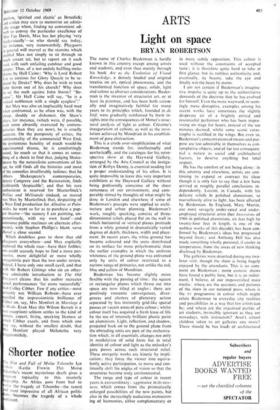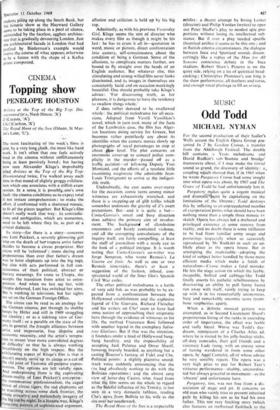ARTS Light on space
BRYAN ROBERTSON
The name of Charles Biederman is hardly known in this country except among artists and students, and even then mainly through his book Art as the Evolution of Visual Knowledge, a densely loaded and original treatise on art, optical phenomena, and the transformed function of space, solids, light and colour as abstract considerations. Bieder- man is the inventor of structurist art, or at least its patentee, and has been both ration- ally and imaginatively faithful for many years to its principles which, founded in de Stip, were gradually reinforced by fresh in- sights into the consequences of Monet's struc- tural analysis of light as colour. Cdzanne's inauguration of cubism, as well as the revo- lution achieved by Mondrian in his establish- ment of pure abstraction.
This is a crude over-simplification -of what Biederman stands for, intellectually and aestheticery, and the catalogue for his retro- spective show at the Hayward Gallery, arranged by the Arts Council at the instiga- tion of Robyn Denny, is essential reading for a proper understanding of his ethos. It is quite impossible to leave this very important exhibition at the Hayward Gallery without being profoundly conscious of the sheer rottenness of our environment, and com- parably stirred by thoughts of what might be done in London and elsewhere if some of Biederman's precepts were applied to archi- tecture and urban planning. Biederman's work, roughly speaking, consists of three- dimensional reliefs placed flat on the wall in which horizontal or vertical planes protrude from a white ground in dramatically varied degrees of depth, thickness, width and place- ment. In recent years, the white ground has become coloured and the units distributed on its surface far more polychromatic than the earlier examples in which the uniform whiteness of the ground plane was enlivened only by units of colour restricted to a narrow range of primaries, not unlike the red, blue and yellow of Mondrian.
Biederman has become slightly more flexible with the passing of time: the square or rectangular planes which thrust out into space are now tilted at angles ; there are positively romantic convergences, diver- gences and clusters of planetary action separated by less insistently grid-like spatial pauses or vacant areas of pure colour ; whilst colour itself has acquired a fresh lease of life by the use of intensely brilliant plastic paint on aluminium. Light, reflection, and shadow, projected back on to the ground plane from the obtruding units are part of the orchestra- tion which, in all essentials, changes not only in modulation of solid form but in total identity of colour and light as the onlooker's gaze passes across each structural relief. These energetic works are kinetic by impli- cation; they force the viewer into equiva- lently active participation, to move and con- tinually shift his angles of vision so that the structures become truly environmental.
The range and type of colour in recent years is extraordinary : aggressive in its new- ness, which comes from the prismatically enlarged possibilities of the new paints, but also in the increasingly audacious manoeuvr- ing of harmonies, either complementary or
in more subtle opposition. This colour is used without the constraints of accepted taste ; it is therefore quite hard to take at first glance, but its ruthless authenticity and, eventually, its beauty, take the eye and finally win the heart by storm.
I am not certain if Biederman's imagina- tive impulse is quite up to the authoritative demands of the doctrine that he has evolved for himself. Even the more wayward, or seem- ingly more disruptive, examples among his recent works have sometimes the slightly desperate air of a brightly attired and resourceful performer who has been impro- vising on stage for hours, instead of the ten minutes decreed, whilst some scenic catas- trophe is rectified in the wings. But even so, Biederman's concentrations of means and pur- pose are too admirable in themselves as con- templative objects, and of far too consequen- tial a nature as social and architectural factors, to deserve anything but total respect.
He has the comfort of not being alone : in this country and elsewhere, artists are con- tinuing to expand or contract his ideas though it is only fair to say that a few have arrived at roughly parallel conclusions in- dependently. Lorcini, in Canada, with his delicate reliefs in polished aluminium, so marvellously alive to light, has been affected by Biederman. In England, Mary Martin, our most savagely under-rated and under- employed structural artist (her Inversions of 1966 in polished aluminium, six feet high by twenty-four feet in length, is one of the noblest works of this decade), has been con- firmed by Biederman's ideas but progressed beyond them ; and Anthony Hill has also made something wholly personal, if cooler in temperature, from the areas of new thinking disclosed by Biederman.
The galleries were deserted during my two- hour visit, though the show is being hugely enjoyed by the attendants. This is no com- ment on Biederman ; more esoteric shows have found a public here, but it is an indict- ment, I believe, of our impoverished mass media : where are the accounts and pictures of the show in our national press, where is the TV programme in colour which might relate Biederman to everyday city realities and possibilities in a way that few artists can be; and where are the organised parties of art students, invincibly ignorant as they are nowadays, with instructors? Aren't school children taken to art galleries any more? There should be bus loads of architectural students piling up along the South Bank, but this historic show at the Hayward Gallery seems to be taking place in a pool of silence, surrounded by the faceless, eggbox architec- ture that is gradually devouring London. Just one architectural facade in London that had profited by Biederman's example would swerve the course of what appears otherwise to be a future with the shape of a Kafka prison compound.











































 Previous page
Previous page